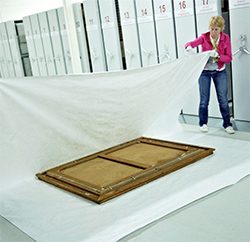Why is Tyvek so good in conservation applications?
Tyvek is used worldwide for a multitude of applications, from protective clothing, to construction material. I am actually sitting here writing this with my lunch bag sat with me (it's only 10am, I must resist) which is also made of Tyvek. But why is Tyvek so popular and why is it useful in conservation?
But why is Tyvek so popular and why is it useful in conservation?
The missing link, sort of…
Tyvek is sometimes called fabric, sometimes called paper, and like both it’s available in rolls and sheets. Part of its strength is that it combines the properties of both of those, it can be printed or written upon like a paper but it will also drape like a fabric. Over and above that however, is that it’s much stronger than paper, and far more versatile than fabric (not to mention a fraction of the price).

Tyvek is a non-woven material, unlike a conventional woven fabric created from a yarn, the fibres are not woven but rather spun, entangled, then heat and pressure bonded. This offers many advantages over conventional fabric and paper.
The image to the right shows a 2.5mm square section of tyvek using a macro lens, darkened to show the random spun fibres in the material. (more close-up images below)
So why is Tyvek good for conservation applications?
It’s archive safe - Firstly, Tyvek is inert and pH neutral. It’s made from 100% HDPE non-woven olefin fibre and contains no binders, fillers or plasticisers. So, it’s safe to use in most archival applications where it may be in direct contact with the object (if in doubt please contact a trained conservator).
It’s a more durable material - The non-woven material finish is very smooth (like paper) and soft (like fabric), so won’t cause damage through abrasion. Being non-woven, it won’t snag and tear, or leave lint - a distinct advantage over fabric, paper or film. It’s tough, but can be easily cut to shape using scissors. This makes it ideal for wrapping and shipping purposes.

It’s breathable, waterproof and dustproof - Any items wrapped will be protected from water and dust, but will also be able to breath, preventing condensation which could encourage mould growth and pests. It will filter out 99.9% of particles from the air down to 0.5-0.7 micron in size reducing risks from many airborne pollutants.
Tyvek is waterproof in the sense that its structure remains stable and unaffected even when submersed in water, it’s just as strong when it’s wet as when it’s dry. In terms of water penetration, water droplets will not ‘wet’ and soak into the surface, they will simply remain as droplets on the surface. Because of its permeable filament structure, Tyvek will allow the transmission of water vapour, allowing contents to breath even if totally enclosed. This permeability does mean however, that objects are protected from splashes and light showers, but not heavier or constant wetting.
You may like to read our blog on textile and costume storage which talks about prefabricated Tyvek garment covers.
Which grade of Tyvek is OK for conservation?
We stock the 1442R and 1623E for conservation applications. These are the recommended grades as they have no coatings or finishes that could cause harm to works of art and are of a suitable weight and strength to provide protection.
What’s the difference between 1442R and 1623E grades of Tyvek?
Both grades are essentially the same material, however, the 1623E is pin perforated (0.25 - 0.38mm in size). This allows for a higher level of permeability and breathability, with additional softness. You can see the small perforations on the photograph below (horizontal lines at 1mm spacing approximately).

If you require higher resistance to water penetration, 1442R is the grade you need. Tyvek 1442R has a hydrostatic head of 850mm, it’s not quite good enough to make a tent out of (tent material is usually rated 1000mm or above) but will resist a shower! Aside from those factors the two are very similar. Both are 145micron, 1442R 1623E is 41.5gsm 1442R 43gsm.
Can Tyvek be glued or fixed?
The answer is yes. Dupont, the manufacturer of Tyvek, recommend that; ‘water-based adhesives that provide quick tack and fast drying are preferred.’ ‘Natural product adhesives based on dextrin, casein or animal by-products can be used to adhere Tyvek® to itself and a variety of paper materials. Water based synthetic lattices such as the ethylene/vinyl acetate adhesives form fibre tearing bonds with Tyvek®. Hot melt polyamide adhesives are available which form good bonds to Tyvek® with a variety of materials. Acrylic pressure sensitive adhesives are commonly used with a release liner. Please refer to the solvents list before using your adhesive. Some of the components may interact with Tyvek®.’
Tyvek can also be heat sealed using a polyester welding machine. Further information on heat sealing and gluing Tyvek is available here.
What should I be using Tyvek for?
Because of its suitability for conservation and flexibility in application, Tyvek can be used in hundreds of different ways – most of which we will leave you to discover (we haven’t thought of!).
Tyvek is available in various width rolls from 760mm up to 3metres.
Here are some of the uses we currently supply Tyvek products for (click here to view our full range of Tyvek products):
Let us know what you’re using Tyvek for @preservation_e